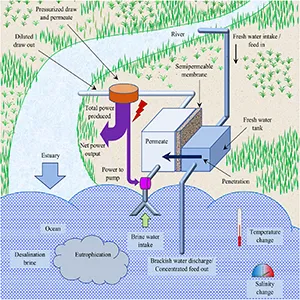
Asia's first 'osmotic power plant' generates electricity using only water, 24 hours a day
On a humid August morning in Fukuoka, Japan switched on Asia’s first “osmotic power plant.” The system runs 24 hours a day at a seawater desalination complex on the city’s eastern shore, generating electricity using the natural process of osmosis.
The plant is the second of its kind worldwide and the first in Asia to operate at this scale. It sits beside pumps that turn seawater into drinking water for hundreds of thousands of people.
How osmotic power works
The project’s day to day effort is guided by Kenji Hirokawa, director of the Seawater Desalination Center at the Fukuoka District Waterworks Agency. His team focuses on practical water and energy pairings that turn waste brine into steady electricity.
At its core is osmosis, the movement of water from a more dilute salt solution to a more concentrated salt solution through a selective barrier. When water crosses that barrier, pressure builds on the more salty side and can be used to spin a turbine.
A membrane – a thin filter that lets water pass but blocks salt – separates treated freshwater from a super-salty stream. That salty stream comes from the desalination plant and raises the pressure available to the turbine.
“It is also noteworthy that the Japanese plant uses concentrated seawater, the brine left after removal of fresh water in a desalination plant, as the feed, which increases the difference in salt concentrations and thus the energy available,” said Professor Sandra Kentish of the University of Melbourne.

What this osmotic power plant adds
The operator reports a net output near 110 kilowatts and about 880,000 kilowatt hours a year, with uptime near 90 percent, according to the report.
Most of that electricity powers the desalination facility on site. Any surplus can offset demand roughly equivalent to a few hundred typical homes in the city.
Because there are no boilers to fire, the osmotic power plant produces electricity without direct carbon dioxide emissions. Water flows, membranes do their quiet work, and the turbine hums.
The benefit is consistency. Solar and wind-generated electricity fluctuate with weather and daylight, but rivers and outfalls keep meeting the sea, so the system keeps turning.
Why it took so long
A 2022 review identifies why many prototypes struggled to deliver net gains at scale. Energy is lost pushing water through piping and channels, and friction inside the modules eats into the harvestable pressure.
The gap between lab and field has been real. Early pilots posted modest outputs, and scaling up exposed limits in pump efficiency and membrane performance that erased much of the expected power.
Norway’s Statkraft opened a 2 to 4 kilowatt prototype in 2009 to prove the idea and test costs. It was tiny, but it put actual numbers on the table and helped engineers map the losses.
Engineers have responded by improving pumps and pressure exchangers, and by designing membranes that reduce internal drag.
They are also tackling fouling – deposits that clog surfaces and slow flow – since clean channels are essential for useful power density.
Where osmotic power works
Pairing desalination plants with osmotic units creates a practical loop. Brine, the very salty water left after desalination, sits next to treated freshwater, so both streams are already available without long new pipelines.
That proximity cuts pumping losses and boosts net output. It also eases brine disposal by diluting salty waste in a controlled way before it returns to the sea.
“I feel overwhelmed that we have been able to put this into practical use. I hope it spreads not just in Japan, but across the world,” said Akihiko Tanioka, professor emeritus at the Institute of Science Tokyo.
Hundreds of estuaries, deltas, and coastal outfalls could host similar systems. The best candidates will be places where concentrated streams already exist and environmental monitoring can confirm safe mixing.
What to watch next
A 2025 review points to faster progress in membrane materials and module layouts. Better polymers, smarter spacers, and compact stacks are pushing more water through at useful pressures with less loss.
This plant uses pressure-retarded osmosis, a method that harvests salinity differences by letting freshwater boost the pressure on the salty side.
Researchers are also refining operating pressures and cleaning routines to keep power density stable over months, not just days.
Near-term growth will likely cluster at seawater desalination hubs that already handle large brine volumes, including facilities in Australia, Spain, the Middle East, and California.
Sites that can pair treated wastewater with brine may get the quickest wins because both streams are right there.
Japan’s installation shows a clean way to turn two waste flows into electricity with almost no drama. If the next iterations keep driving down internal losses, round-the-clock blue energy could become a small but dependable part of coastal power.
Information from a press release by The Renewable Energy Institute.
—–
Like what you read? Subscribe to our newsletter for engaging articles, exclusive content, and the latest updates.
Check us out on EarthSnap, a free app brought to you by Eric Ralls and Earth.com.
—–













